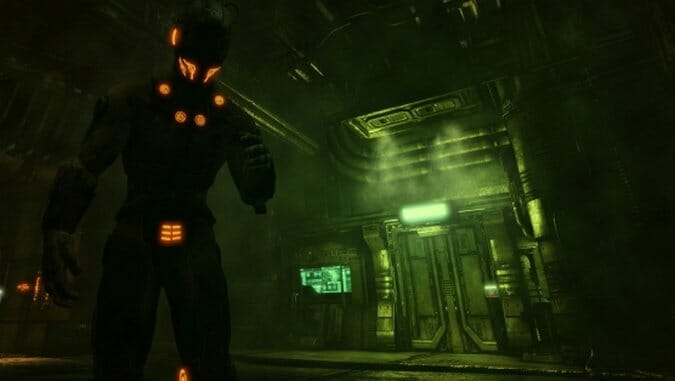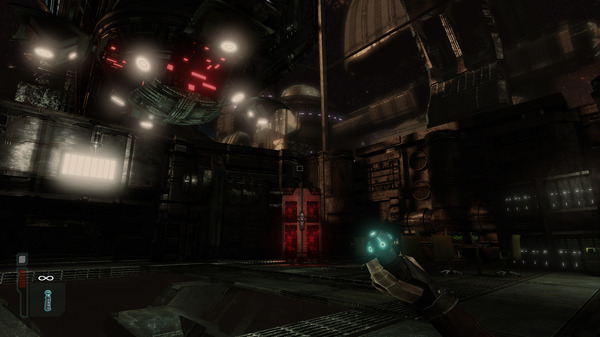
A popular trend in independent game design has been reviving genres the big publishers won’t make anymore, like survival horror and 2D action games. Some people await the time when indies start trying to bring back immersive first person action experiences of the tradition that brought us the classics Deus Ex, Thief and System Shock. We’re starting to get a few attempts like Eldritch and Neon Struct from Minor Key Games. A lesser known recent attempt is the sci-fi horror-themed stealth game Solarix from Pulsetense Games. The resources available to an indie group like Pulsetense ultimately clash with the scope and breadth of what these games entail, but Solarix still manages to be an interesting and engaging diversion from today’s standard first person action game.
A somewhat popular term for these kinds of games is “immersive simulation.” In short they are 3D games, usually first person, that offer players a variety of ways to deal with problems in a world that feels functional and reactionary to their actions. Solarix is a near shameless homage to the aforementioned classics. Pulsetense seemingly designed it to satiate people starved of that type of action and atmosphere. It tries to combine the original Deus Ex with the light-and-sound stealth of Thief and System Shock’s space ship of horrors.
You get the usual sci-fi horror story here where things have gone seriously wrong in a dark futuristic setting—in this case a human colony on an alien world where everything looks like the ship from Event Horizon. Of course you have to fix everything while trying to escape. For good measure Solarix includes among its major characters artificial intelligences and other mysterious personalities of questionable trustworthiness.
Solarix is mainly a stealth game. It gives you some weapons but very little ammo. More importantly, when enemies are alerted they become extremely aggressive and persistent. They usually kill you within a few seconds, which makes open combat impossible a lot of the time. Choosing to fire your weapon in Solarix is a big decision and usually a last resort.
This makes sneaking around pretty tense despite the game not actually being that difficult overall. The first sign I saw of Solarix’s design intentions hitting its technical limitations was how its enemies aren’t very smart. Interestingly, the game writes around this by portraying all of them as either zombies or insane.
The game gives you a few different options for dealing with enemies. You can destroy lights which is extremely risky. Luring enemies with sound by throwing objects or running becomes important during a middle section where you have no weapons. Enemy patrols however are pretty small and obvious which makes avoiding detection easy most of the time. My main play style involved sneaking behind enemies one-by-one and incapacitating them with a zapper from behind. It’s not hard to clear out whole rooms like this.
The levels you sneak through aren’t very complex either and are actually quite linear given the design style Solarix claims to follow and how Pulsetense advertises it. That said, it still successfully delivers a sense of place most modern shooters have forgotten. Solarix is more or less the kind of game that wants you to explore all the paths and locations you can in order to progress, and lays them out intelligently enough. Instead of just following waypoints it wants you to read a map and constantly reference your objective notes. In one late section you find an elevator out of power, and enough exploring eventually nets you an email describing a cargo container with a fuse inside along with the code for the container. It’s simple but requires at least a bit more brain power than the normal waypoint-driven design you get these days.
The environments themselves manage to pull off a suitably dark and moody sci-fi horror feel despite the game’s modest technical muscle. Solarix honestly looks like a single step above the graphics of the 1999 System Shock 2, which should be expected of a small group making a game like this. The sound design really helps out though, particularly the mechanical rumblings of the space ship and the enemies’ insane rambling. The latter not only makes their dumb AI understandable but makes them more intimidating.
While Solarix relies on the now popular storytelling device of dropping audio and text logs everywhere, it’s not egregious with the implementation. They all make sense as messages people would actually leave behind and even offer well-paced development of several characters’ parallel stories which nicely compliment the main story. The voice acting certainly doesn’t hurt it.
Ten or twelve years ago Solarix would probably fit right in as a merely average game. In 2015 however it stands out a bit as a diversion from the usual sci-fi action we’ve come to expect from games, and part of the first real wave of an indie immersive sim revival. Although it clearly feels like a miniature version of the games it emulates, Solarix still offers a small bite of an experience players have been starved of for years.
Solarix was developed and published by Pulsetense Games. It is available for PC.
Daniel Sims is a freelance writer. He tweets @RedSwirl and maintains a blog about gaming called Multiplatform, where you can find his other work.
